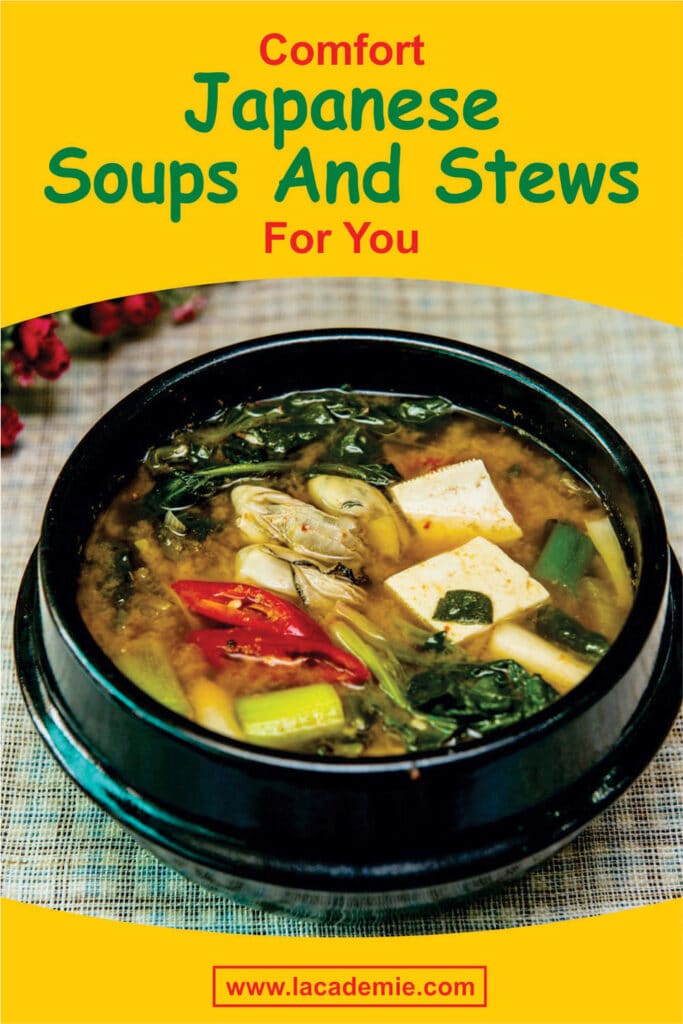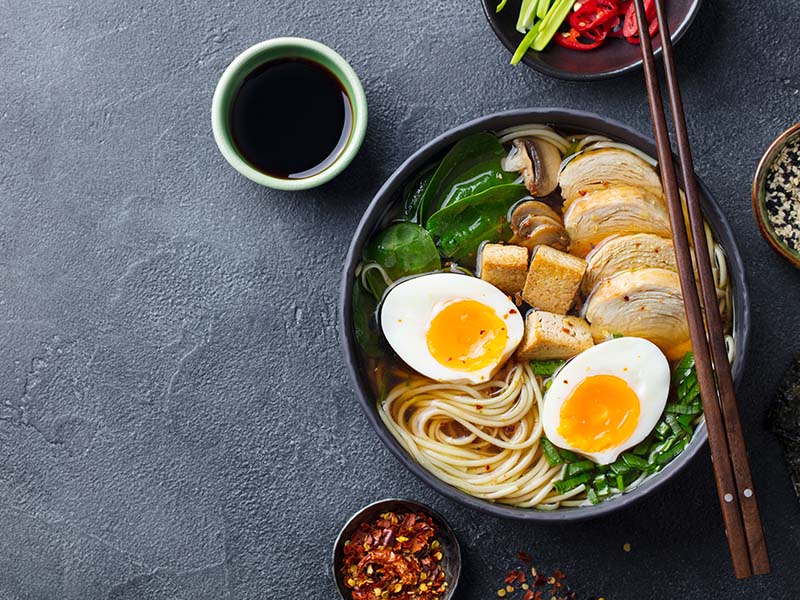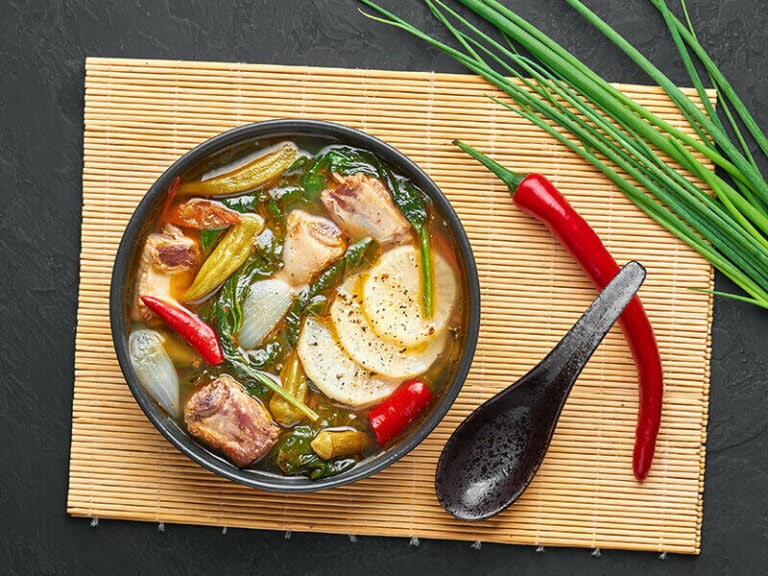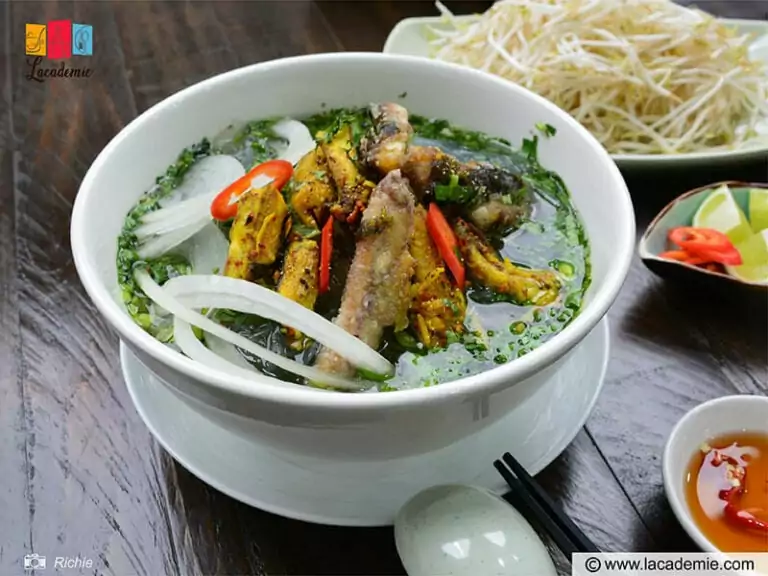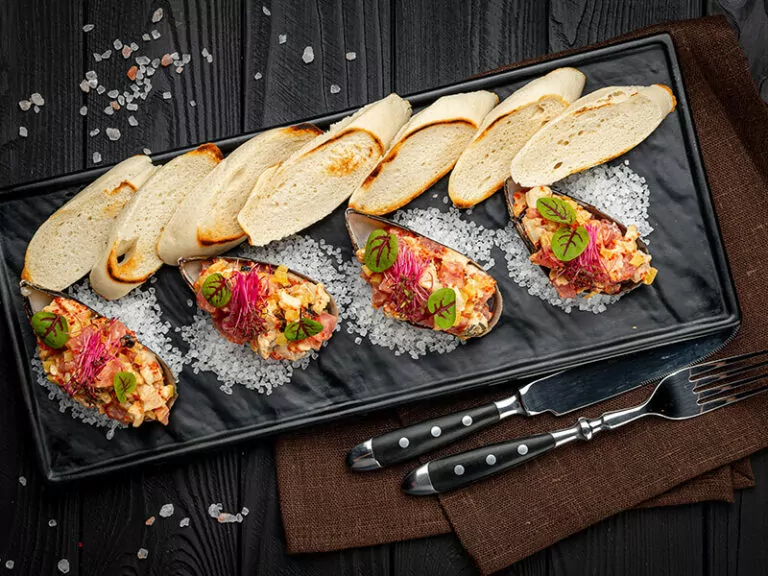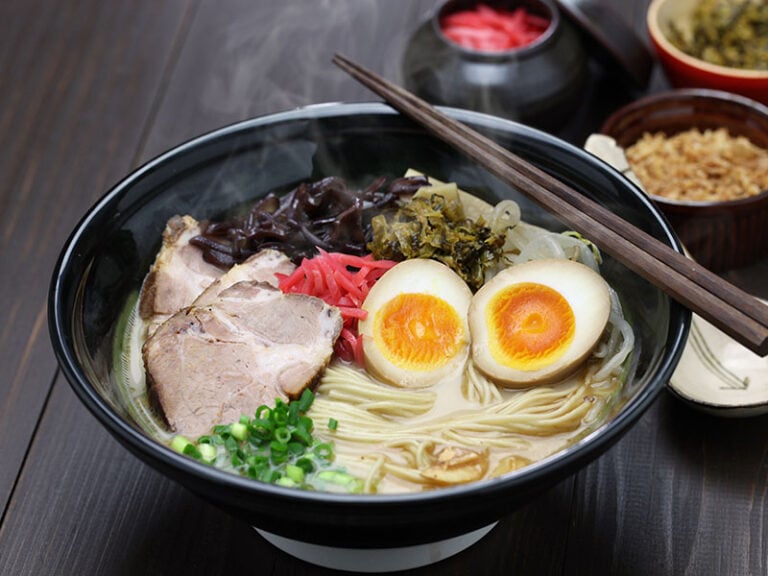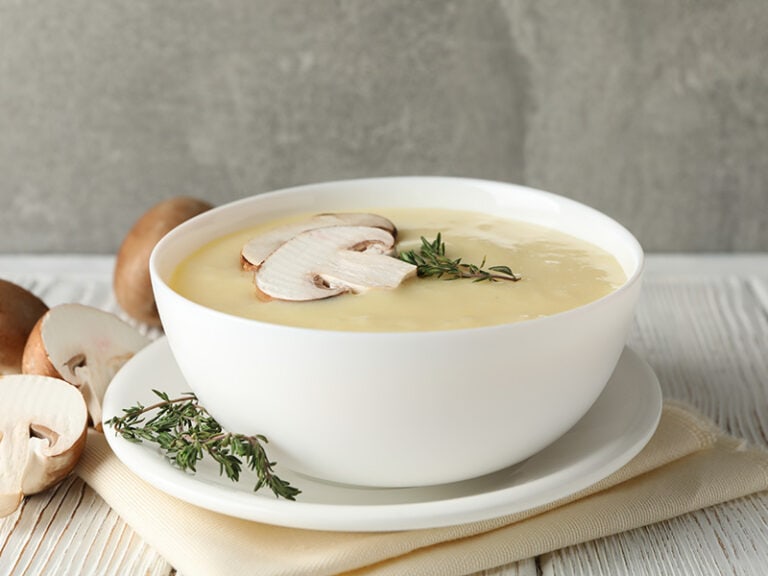Since Japan has a very cold winter every year, many Japanese soups and stews recipes have been created. Some of them are only made occasionally; some are year-round dishes. But all of them can warm you up against the freezing temperatures.
In this post, I will show you how diverse Japanese cuisine can be with soups and stews. From savory ones, like classic Miso Soup, to sweet comfort snacks, like Zenzai, the list is amazingly versatile with limitless possibilities.
And there are numerous choices of soups and stews for you that can confuse you. Therefore, I am here to help you with my collection of 16 selective Japanese soups and stews that you should try.
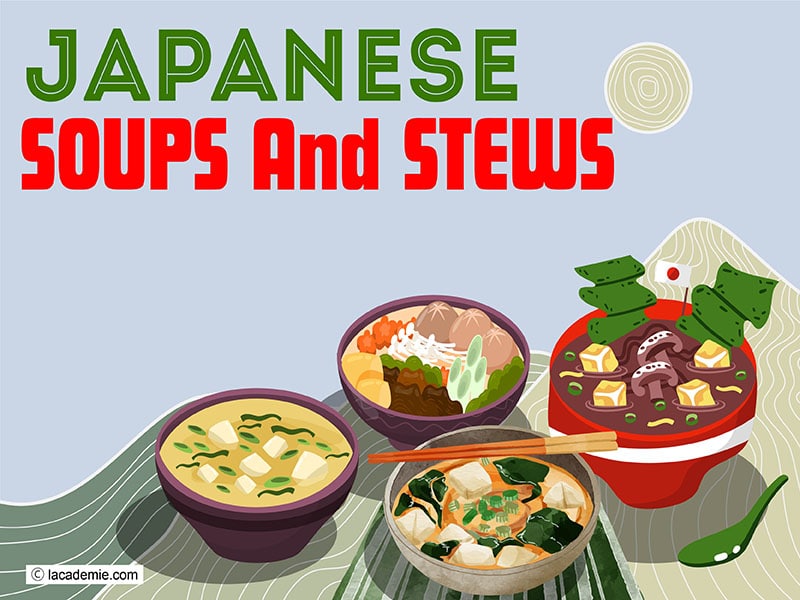
Here Is Your Beginning To Become A Japanese Soup And Stew Master
The Japanese often make soups and stews during the cozy season. Therefore, you can feel assured by their knowledge about this territory of the culinary world. Without further ado, I would like to introduce 16 Japanese soups and stews that you need to know.
1. Zouni/Ozoni (Mochi Soup)
Total time: 30 minutes
Zouni, or Ozoni, is a special soup that the Japanese make during their first day of the Lunar New Year. In Japanese, “zouni” means “mixed simmered soup”. There are over a hundred types of Zouni in Japan, and each prefecture has several recipes due to their specialties.
The Zouni that people often see is the Kansai-style one. Its broth is opaque since it’s made of White Miso, Sake, and Dashi broth. The flavor is highlighted by the mild sweetness of Miso and Dashi’s umami.
The Dashi broth is made by simmering Bonito flakes (fermented and smoked tuna) and Kombu (dried kelp) for at least 30 minutes. This is one of the most crucial elements of Japanese cuisine.
The typical toppings of the Kansai recipe are Mochi (rice cake), Daikon (Japanese radish), and Kamaboko (Japanese red fish cake). And in this recipe, Mochi has a round shape, and it is boiled before adding to the soup.
The one that receives the same fame as Kansai Zouni is its counterpart from the Kanto region. The two have some distinctive points: their broth’s components and topping options. And the recipe in this post assembles the Kanto-style Zouni.
Kanto Zouni has a soy base for the broth instead of White Miso. Therefore, it has a savory flavor and heavier umami compared to Kansai one. Kanto’s Mochi is also different since it is square and grilled. Toppings here are more earthy with shiitake, chicken, and leafy veggies.
2. Zosui (Rice Soup)
Total time: 15 minutes.
Sometimes having rice and soup separately is kind of boring. To eliminate this boredom, the Japanese decide to put their rice into their soup pot and create Zosui. Zosui is a simple dish from mushrooms and other ingestible vegetables, like onions.
The rice in this dish is undercooked, so when you add rice to the soup, the kernels can still keep their shapes. The broth is pretty basic with Dashi stock and soy sauce.
Zosui can also be a Japanese-theme vegetarian recipe by using the Shiitake Dashi stock instead of the regular one. People replace Bonito flakes with dried shiitake mushrooms when they make the broth.
This tasty gluten-free Japanese dish is simple and can be prepared in under 30 minutes. It is what the Japanese make when they are under the weather. The taste is slightly sweet and salty with the contribution of rice and Dashi. Other components are easy to digest, which makes it good sick food.
With this guide, you can easily learn how to make Zosui for your next dinner.
3. Nikujaga (Beef And Potato Stew)
Total time: 30 minutes.
In Japanese, “niku” means beef, while “jaga” means potato. The name illustrates the two main ingredients of the dish. But to make Nikujaga, you still need to buy carrots, green beans, and onions.
This recipe recommends you make Konjac jelly to eat with this dish since this type of noodle contains fewer carbs than the other. But you can eat it with rice or noodles if you want to. This starchy ingredient is optional.
Stew is the best way to enhance the tenderness of the meat. With the broth components like Sake, Mirin, soy sauce, Dashi stock, and sugar, your beef develops a mouthwatering taste. You can feel umami and saltiness combined with your saliva every time you take a bite.
4. Kenchinjiru (Vegetable Soup)
Total time: 50 minutes (including 30 minutes of mashing tofu).
If you are a vegan, then you have to know this recipe. Kenchinjiru contains vegetables and tofu only. Even the Dashi broth in this dish doesn’t include Bonito flakes like other recipes. And this dish is representative of Shojin Ryori (Japanese Buddhist cuisine).
Kenchinjiru originated from a temple and was invented accidentally by a monk. The remarkability of this dish is the smashed tofu composition in the soup. This addition enhances the soup’s sweetness compared to regular vegetable soup.
Typical ingredients of this recipe are firm tofu, vegetables like Satoimo (Japanese taro), Daikon, carrot, and shiitake mushroom. In some other recipes, people also add shimeji mushroom and burdock root.
The sweetness from vegetables is just slightly sweet, while the broth contributes a nice umami touch. The top-notch flavor of this dish is another distinctive sweetness from smashed tofu.
5. Butajiru/Tonjiru (Pork Soup)
Total time: 30 minutes.
The three main ingredients of this soup are pork, vegetables, and Miso for the Dashi broth. The pork is regularly sliced into thin pieces so the essence of pork meat can blend more into the soup.
People often buy typical vegetables like carrots, onions, and potatoes. They would often add noodles (usually Shirataki – Japanese Konjac noodles) into the soup and have it as their lunch.
An important highlight that I need to address about this dish is its broth base. Traditionally, the Dashi broth is flavored with White Miso. This kind of Miso has a mild sweet taste that can add a comfortable sweetness to your soup, and that’s the taste you need in Butajiru.
6. Misoshiru (Miso Soup)
Total time: 55 minutes.
To have a standard staple Japanese meal, you need to have a soup dish. One of the most common options for this daily soup dish is Miso soup. With just several ingredients, you can easily make your own Miso soup at home and enjoy it.
For the soup, you need to prepare Dashi stock and Miso for basing. Traditional Miso soup includes tofu, Wakame seaweed, and onions. And for garnish, people add chopped scallions and Aburage (fried tofu) on top.
The synchronization of tasting umami flavor in the soup and the feeling of warm liquid running along your throat is a euphoria of enjoying food. Miso soup is like a “cherry on top” of Japanese cuisine that you should not miss out on.
Miso soup is definitely a dish that you should add to your daily menu ASAP.
7. Kasujiru (Sake Lee Soup)
Total time: 30 minutes.
The protagonist of this “Kasujiru” movie is Sake Kasu – a special condiment of the Japanese. When the Japanese distill Sake or Mirin, the lees (residual yeast) are often used as a marinade or soup-base instead of tossed away.
In this recipe, you would use Sake Kasu to add creaminess and flavors to your soup. This addition is compatible with other ingredients like fried tofu, konjac jelly, carrot, and onions. The taste is also enhanced by Miso and Dashi stock.
The umami and acidity of the broth compliment the participation of salmon filets. Japanese people love having this soup during cozy days. Kasujiru is also nourishing due to its Sake Kasu element since it is highly rich in protein, vitamins, and fiber.
8. Noppei/Noppe (Leftover Vegetable Stew)
Total time: 45 minutes.
Just like Kasujiru, Noppei is also a dish that has its traditional origin in the Japanese “no waste” cuisine. This stew is supposed to cook with the leftover vegetable part. Therefore, the veggies are often chopped into small cube pieces.
There isn’t a fixed recipe for this soup, and the veggies component can be very flexible due to your desire. Perhaps, the most common ones are taro, carrot, lotus root, and konjac jelly.
Besides veggies, people often add protein sources into the soup pot. In this recipe, Kamaboko and scallops are the ones. These two can give your Noppei a comfortable salty seafood taste. Plus, the umami from soy sauce-based broth makes this dish extremely superb.
To make this dish, you need to add all the ingredients to the Dashi stock at or over medium-high heat. And then you let all the things simmer in the pot for 20 minutes. When the taro starts to be soft, you know that your soup is ready.
9. Suimono (Clear Soup)
Total time: 20 minutes.
Just like Kenchinjiru, Suimono is a typical recipe of the Japanese vegan. The most iconic thing about this soup is how limpid the broth is. Since you only need Dashi stock, Mirin, and soy sauce for the broth, the color of Suimono’s liquid is very clear.
This Suimono recipe is also very fragrant due to the matsutake mushroom element. This kind of “take” (mushroom) is dense with the aroma of pinewood (“matsu”). It makes you feel like you are walking in a forest during autumn with all the pinewood smell in the air.
For this recipe, you only need simple ingredients like mushroom, silken tofu, and parsley. It is also known for the addition of chewy Temari Fu (Japanese non-fried crouton balls). Having this is like adding a colorful-looking garnish to your soup.
10. Kurimu Shichu (White Stew/Cream Stew)
Total time: 25 minutes.
Japan was involved in many world-historic events, and its culture was shaped by many influences from Chinese and Western countries. The formation of Yoshoku cuisine is the “necessary and sufficient” condition for creating White Stew.
White Stew is one of the representatives of chicken recipes in Japan. Unlike the other stews and soups, White Stew doesn’t contain any regular Japanese base like Dashi stock, soy sauce, or Miso.
For the broth, Japanese people use Bechamel sauces (a traditional French sauce) to make the soup. Other ingredients that you need to prepare are chicken breast and vegetables like carrot, potato, onions, and green peas.
The difference in using Bechamel sauce colors the picture of Japanese food culture. With charming soup, tender chicken, and soft vegetables, this dish gives you a nice harmony of delicacy and nutriment.
11. Ushio Jiru (Clam Soup)
Total time: 2 hours and 15 minutes.
Every year, on March 3rd, the Japanese celebrate their Hinakazari (their traditional doll set of the Emperor and the Empress) and call it “Girls’ Day” or “Doll Festival”. And during this seasonal festival, they make a special dish named Ushio Jiro.
For this soup, people prefer using Kombu Dashi (only have Kombu in it) instead of regular Awase Dashi. This is for enjoying the natural taste of the clams. The resulting soup needs to include umami from Kombu broth and the sweetness from Sake and clams.
The garnish is also uncomplicated with just parsley or cilantro. The taste is elegant, and the look is appetizing. You can have this soup with your morning rice to warm your tummy before starting your workday.
12. Zenzai/Oshiruko (Sweet Red Bean Soup With Mochi)
Total time: 1 hour and 5 minutes.
I think you have learned enough about salty dishes. It’s time to convert the theme with an awesome dessert of the Japanese, like Zenzai. The Japanese have it throughout the year. Therefore, if you are a fan of Japanese cuisine, you should try to make this dish as well.
To make Zenzai, you need to soften the Azuki beans (red beans) by simmering them for at least one hour. You can skip this step by using the red bean paste. With this method, you don’t have to add more sugar since the paste already has its sweetness.
Normally, you need to serve this dish with Mochi or Dango (a Japanese glutinous rice cake). Another alternative is tapioca pearls (boba). The chewiness of this addition gives the dish more texture and flavors than just a bowl of plain red bean soup.
Zenzai is a great end to your dinner, so you should learn how to make it.
13. Kare (Japanese Curry)
Total time: 1 hour and 40 minutes.
Is curry a stew? That question has sparked a controversial argument among food lovers around the world. And in this post, I proudly say that curry is a stew, or at least Kare is a stew.
Although Kare is a distant relative of Indian curry, they drastically differ in their condiment components. If Indian curry includes strong contributions from cumin and turmeric, the Japanese one tastes lighter with soy sauce’s umami and mild flavor of the curry roux.
There are many ways to make curry in the Japanese style, but in this recipe, chicken curry is the center of attention. To make this dish, you need to cut the chicken into bite-size pieces. You also want to stir-fry your chicken before stewing the chicken with vegetables for an hour.
This dish is incomplete if you don’t serve it with rice. Medium-grain rice is my option every time, but short-grain one like in the recipe is not a bad option. Besides rice, Udon noodle is also a common starchy choice for this dish if you want to add more carbs.
14. Buri Daikon (Simmered Yellowtail With Radish)
Total time: 20 minutes.
This section is about Daikon – Japanese radish and Yellowtail (Japanese amberjack) being the “in the limelight” duet of the “Buri Daikon stage”. The Japanese favor having this dish during wintertime since this is the season for both ingredients.
To stew Buri Daikon, you need to prepare the simmering broth from Sake, soy sauce, and sugar. This is another dish that Dashi stock has no involvement in, which is rare in Japanese cuisine.
There are several pre-works that you need to complete before the simmering part. Your Daikon needs to be cooked since the cooking only takes 15 minutes.
After that, you can submerge all the ingredients in a pot with your broth and let it cook. The dish is pretty salty alone, so you would like to serve rice with it. Togarashi (Japanese pepper powder) is also necessary if you want to add some spiciness to your Buri Daikon.
15. Jibuni (Simmered Chicken And Tofu)
Total time: 20 minutes.
Kanazawa city has several precious culinary signatures, and one of them is Jibuni. This dish expresses the flavor of the duck, which is not a common ingredient in Japanese cuisine. People consider this a hot pot in Japan, but its intrinsic nature is a stew.
A common substitute for duck meat that I have to mention is chicken. You can use chicken thighs, like in the recipe, to replace duck since some people can’t tolerate the fatty meat of the duck.
To make this dish, the required ingredients are tofu, shiitake mushrooms, carrot, and spinach. Some others also add lotus root and Daikon. Matsutake is not recommended because its fragrance can overwhelm the whole stew’s flavors.
For the broth, it is pretty basic with Dashi stock, Mirin, Sake, and soy sauce. You should enhance the viscosity of the broth with cornstarch as well. My final suggestion with Jibuni is to have it with Wasabi (grated Japanese horseradish) to give the dish a more intense flavor.
16. Imoni (Taro And Beef Soup)
Total time: 45 minutes.
The Japanese love having Imoni during the autumn rainy days. This dish is a signature dish of Yamagata prefecture. The region has its own celebration for this dish called Imonikai (Imoni parties). It is one of the most vital festivals in autumn to the Yamagata people.
The dish is made from local specialties like taro, konjac jelly, and thinly sliced beef. Some other ingredients that you should consider are burdock root, ginger root, and some mushroom kinds.
The broth is also basic with the participation of Dashi stock, sugar, Sake, and soy sauce. It is also suggested to have this soup with Udon noodles. And if you want to increase the heat for the broth, Togarashi is the suitable option for you.
The umami and beefy flavor of the dish make you feel healthy and comfortable. In Japan, people prefer making this dish during outdoor activities like picnicking. The warmth that Imoni brings to you is irresistible during autumn days.
A quick instruction like this can easily help you make Imoni soup in no time.
Are You Ready To Warm Yourself Up With Japanese Soups And Stews?
I hope that you also recognize Japanese cuisine’s versatility since they can create a whole menu with just the soups and stews category. After this post, you know that you can make Imoni for your appetizer, curry for your main course, and the dessert can be Zenzai.
What do you think of these 16 recipes of Japanese cuisine? Do you think you would make some of them in the next cold season at your place? If you like these dishes, please share your experiences with me in the comment section below.
And that is the end of today’s trip. Oh, and don’t forget to share this post with your fellas as well. They might want to learn more about these miraculous recipes with you. Until next time, take care!
Nutrition Facts
4 servings per container
- Amount Per ServingCalories223
- % Daily Value *
- Total Fat
3.9g
5%
- Sodium 1271mg 53%
- Potassium 276mg 8%
- Total Carbohydrate
45g
15%
- Dietary Fiber 3g 12%
- Sugars 6.7g
- Protein 5.8g 10%
- Calcium 19%
- Iron 1%
* The % Daily Value tells you how much a nutrient in a serving of food contributes to a daily diet. 2,000 calories a day is used for general nutrition advice.
